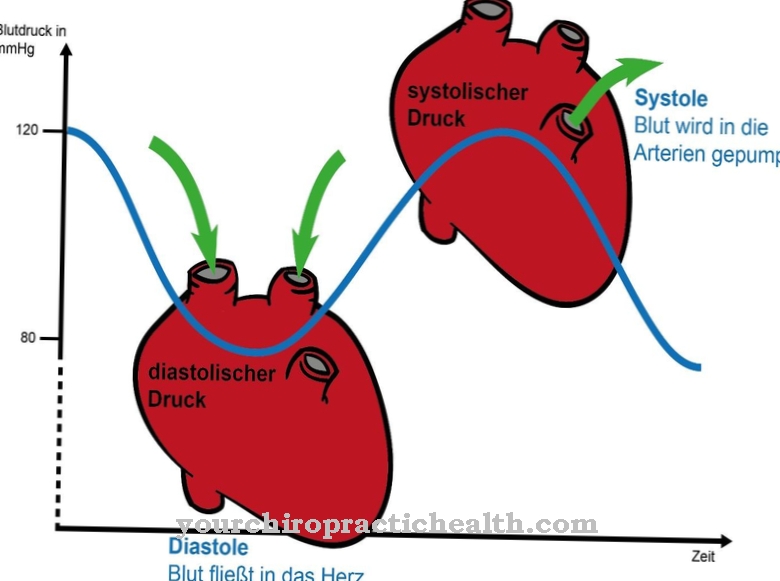As Membrane flow all processes of the intercellular mass transfer via the endomembrane system are summarized. These include, above all, endocytosis, exocytosis and transcytosis, which enable cells to absorb and release substances by shifting the membrane. Disturbances in membrane flow can cause cell death (apoptosis).
What is the membrane flow?

The transport of substances between the individual cells of the body corresponds to the transport of the membrane. The two most important methods of intercellular mass transport are endocytosis and exocytosis. During exocytosis, substances are released from a cell. In endocytosis, on the other hand, non-cellular materials are absorbed into a cell. With this aim, the cell turns inside and thus constricts the substance in its cell membrane. This process creates vesicles and vacuoles.
If a biomembrane partially shifts itself during the mass transfer, we speak of membrane flow. The membrane flow takes place in the endomembrane system. This system corresponds to the totality of all eukaryotic organelles between which there is a connection for vesicular transport.
In addition to the endoplasmic reticulum, the endosomes, the lysosomes and the plasma membrane (cell membrane), the Golgi apparatus is also part of the endomembrane system. In contrast, peroxisomes, mitochondria and the cell nucleus are excluded from the system. S.
Both endocytosis and exocytosis should be mentioned as transport processes in the context of membrane flow. A third transport route of the membrane-displacing substance transport is transcytosis, i.e. the receptor-mediated transport of a substance through a cell membrane.
Function & task
The endocytosis of the membrane flow (or membrane-displacing material transport) corresponds to an invagination of the biomembrane. The cell absorbs a drop of liquid, certain macromolecules or large parts of food through the invagination. Sometimes it turns even smaller cells into its membrane.
After the substance has been incorporated, the cell constricts an endosome in the cytoplasm, which from then on belongs to the endomembrane system. The surrounding medium partially migrates into the cell interior. Endocytosis is either phagocytosis, targeting solid particles, or it is equivalent to pinocytosis and absorbs dissolved molecules.
In connection with membrane flow, receptor-mediated endocytosis is also relevant, in which asialoglycoprotein receptors ensure particle recognition and thus trigger uptake into the cell interior. This type of membrane flow is relevant for the uptake of cholesterol, for example.
A distinction must be made between exocytosis and endocytosis of the membrane-relocating transport of substances. During this process, substances are transported out of the cell interior and released into the cell's surroundings. The substances transported in this way are, for example, substances that are produced by the cell itself. But indigestible remains can also leave the cell in this way. A so-called exome or transport vesicle fuses with the membrane of the cell during the transport process. A lipid bilayer envelops the exome on the outside.
Normally, exocytosis is associated with endocytosis and is then called exocytosis-coupled endocytosis. The combination of endocytosis and exocytosis prevents unhindered cell enlargement. The exocytosis-coupled endocytosis also saves the cell from synthesizing vesicles and membrane proteins for transport purposes. For this reason, Vesicle recycling is often used here.
The third transport route of membrane flow is transcytosis, which is also known as cytopempsis. This is a receptor-dependent transport that transports extracellular material through a cell and thus corresponds to a combination of exocytosis and endocytosis. The vesicle formed in the process releases the cell to a neighboring cell or transports it into the extracellular space. The content of the vesicle remains unchanged. This mode of transport mainly affects the epithelial cells in the blood vessels and intestines.
The main known receptors for transcytosis are Fc receptors of a certain group, which can be found in the placenta and in the apical infantile intestinal epithelium. In the placenta, they are primarily responsible for transporting maternal IgG into the child.
You can find your medication here
➔ Medicines against memory disorders and forgetfulnessIllnesses & ailments
If the transport of substances is disturbed by membrane-changing transport processes, this is often due to a mutation in the transport proteins, transport enzymes or receptors involved. A number of diseases are associated with defective membrane transport.
Tumors, for example, are associated with difficult endocytosis. The same applies to infections and neurogenerative diseases such as neuropathies with restricted walking ability and reduced nerve conduction speed or sensory disorders. For example, endocytosis is disrupted in Huntington's disease. In these diseases, dying nerve cells trigger symptoms such as movement disorders and changes in personality. A mutation in the protein huntingtin is the cause of the disease.
Disturbed exocytosis can have serious consequences as well. For example, the exocytosis of neurotransmitters can be hindered by toxins. Bacterial toxins can cause cramps or paralysis by obstruction of the membrane flow. Exocytosis is also affected by disorders in metabolic diseases such as cystic fibrosis. In this disease, in addition to the bronchial secretions, the pancreatic and biliary secretions become viscous, which leads to functional disorders of the organs. Disturbed pinocytosis is now associated with diseases such as Alzheimer's, with metabolic disorders, elevated cholesterol levels and changes in personality.
Ultimately, disturbed membrane flow can also result in severe disorders in the gastrointestinal tract and is therefore sometimes associated with gastrointestinal diseases. The effects of restrictions in the membrane flow are correspondingly diverse and in the worst case result in cell death. In the context of membrane flow disorders, the cells are often unable to absorb any or only a few vital substances and can hardly or no longer excrete superfluous or even toxic substances.


























